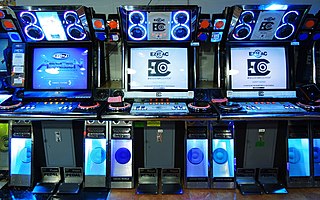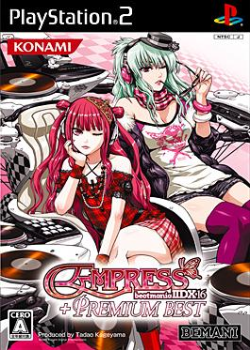Dance Dance Revolution (DDR) is a music video game series produced by Konami. Introduced in Japan in 1998 as part of the Bemani series, and released in North America and Europe in 1999, Dance Dance Revolution is the pioneering series of the rhythm and dance genre in video games. Players stand on a "dance platform" or stage and hit colored arrows laid out in a cross with their feet to musical and visual cues. Players are judged by how well they time their dance to the patterns presented to them and are allowed to choose more music to play to if they receive a passing score.
Beatmania (ビートマニア) is a rhythm video game developed and distributed by Japanese game developer Konami and first released in December 1997. It contributed largely to the boom of music games in 1998, and the series expanded not only with arcade sequels, but also moved to home consoles and other portable devices, achieving a million unit sales. The Bemani line of music games from Konami is named after the series, was first adopted in the arcade release of Beatmania 3rdMix and kept ever since. The series came to an end with the last game being Beatmania The Final, released in 2002.

Beatmania IIDX (IIDX) is a series of rhythm video games, that was first released by Konami in Japan on 26 February 1999. Beatmania IIDX has since spawned 31 arcade releases and 14 console releases on the Sony PlayStation 2. It is the sequel to the beatmania game series, and is part of the Bemani line of music games.
Bemani, stylized as BEMANI, is Konami's music video game division. Originally named the Games & Music Division (G.M.D.), it changed its name in honor of its first and most successful game, Beatmania, and expanded into other music-based games, most notably rhythm games such as Dance Dance Revolution, GuitarFreaks, and DrumMania.

Keyboardmania is a rhythm video game created by the Bemani division of Konami. In this game up to two players use 24-key keyboards to play the piano or keyboard part of a selected song. Notes are represented on-screen by small bars that scroll downward above an image of the keyboard itself. The goal is to play the matching key when a note bar descends to the red play point line. The arcade cabinet has two screens - one for each player.

EZ2DJ is a series of music video games created by the South Korean company AmuseWorld. Basic gameplay is similar to Konami's beatmania series. The first edition of EZ2DJ was introduced in 1999 and the last version, EZ2DJ Azure Expression ~Integral Composition~, was released in June 2012. Afterwards, following the lawsuit by Konami, the rights for franchise were given to Square Pixels company, and development continued under the title of EZ2AC, with latest version being EZ2AC Final EX, which was released in August 2020.

beatmania IIDX 10th Style is the tenth game in the beatmania IIDX series of music video games. It was released in arcades by Konami in early 2004.

Beatmania IIDX 9th Style is the ninth game in the beatmania IIDX series of music video games. It was released in arcades by Konami in 2003. The game features over 50 new songs, some of which can be unlocked using Konami's e-Amusement platform – which made its official debut on 9th Style.

beatmania IIDX 7th Style is the seventh game in the beatmania IIDX series of music video games. It was released in arcades by Konami in March 2002.

Beatmania IIDX 6th Style is the sixth game in the beatmania IIDX series of music video games released in arcades by Konami in 2001 and features 40 new songs. 6th Style introduced new features such as letter grades and the new hard mode.

beatmania IIDX 5th Style is the fifth game in the beatmania IIDX series of music video games. It was released in arcades by Konami in 2001. The game features 35 new songs, five of which are hidden. New features introduced in this version are auto-scratch, as well as two more Hi-Speed settings 5th Style's songlist featured the first songs that would later become "flashing 7s", here differentiated from regular 7s with a kanji meaning "forbidden".

beatmania IIDX 3rd Style is a music video game developed by Bemani and published by Konami, initially released as an arcade game in Japan on February 25, 2000, and subsequently ported to the PlayStation 2 on November 2. 3rd Style removed the 4-keys mode from previous installments and replaced it with the Light7 difficulty, giving most songs a fully separate, easier notechart. The game also introduced Free Mode and Extra Stage, and featured a new aesthetic.
Beatmania IIDX Club Version was released on April 21, 1999 by Konami to the Japanese arcade audience. It could be linked with a Dance Dance Revolution machine for simultaneous play.

Beatmania IIDX is an arcade music video game developed by Bemani and published by Konami. It was released in Japan on February 26, 1999. The objective is to perform songs using a controller with seven keys and a turntable. After the surprise success of Beatmania, Benami conceived IIDX to simulate an actual disc jockey (DJ) live performance. Its arcade cabinet contains a widescreen monitor, speakers, and eight spotlights. Bemani later developed several updated versions of IIDX to increased success. The game retrospectively received a positive reception from video game publications for its gameplay and increased difficulty. A sequel, Beatmania III, was released in 2000.

Beatmania IIDX 16: Empress is the 16th game in the Beatmania IIDX series of music video games. It was released in arcades by Konami on November 19, 2008. The game features over 50 new songs, some of which are unlocked over Konami's e-Amusement platform. The design of Empress's interface is based on a pink color scheme, dominated by sparkles, butterfly wings, and motifs of royalty and jewellery. A PlayStation 2 port for the game was released on October 15, 2009, in Japan.

Beatmania IIDX 17: Sirius is the 17th installment in Konami's Beatmania IIDX series of music video games. The main motif of Sirius's UI is astronomy, as the game is named after Sirius, known to be the brightest star in the night sky. Public location tests began on May 27, 2009, and the game itself was released on October 21, 2009.

Sound Voltex is a series of music games developed and published by Konami. The first release of the game, Sound Voltex Booth, was tested in various cities in Japan from August 26, 2011 until September 19, 2011. It was then released on January 18, 2012. Since then, 5 sequels have been released, with the latest version, Exceed Gear, being the first to release in North American territories.

Beatmania IIDX 21: Spada is a music video game and the 21st installment of Beatmania IIDX series of video games. The main motif of the game revolves around swords, as the title of the game, Spada is Italian for sword. The UI has a medieval fantasy theme and mainly features black, brown, and red colors. It was first announced on June 12, 2013. Location tests began in Akihabara on June 14, 2013 and ended on June 16, 2013. It was released on November 13, 2013.
Dance Dance Revolution A20 is a music video game, the 16th installment of the Dance Dance Revolution arcade series in Japan, and the sequel to Dance Dance Revolution A. The game was released on new, golden cabinets on March 20, 2019, in Japan. A software upgrade for older cabinets for Japan and Asia was released on July 24, 2019, with South Korea receiving a localized release on August 1, 2019, and North America on September 24, 2019. A location test in Europe began on October 7, 2019, and ended on March 16, 2020.

Beatmania IIDX 27: Heroic Verse is the 27th installment of the Beatmania IIDX series. It takes on the theme of superheroes within a rhythm game multiverse, and was the first arcade game in its series to have an official release in North America.
















